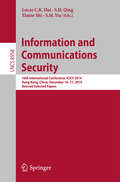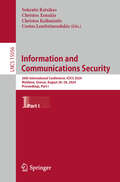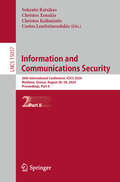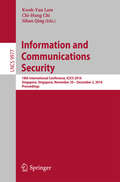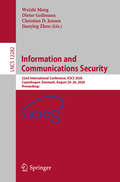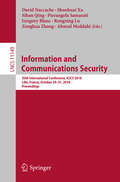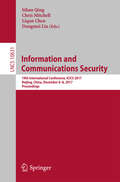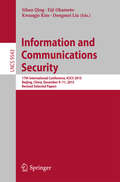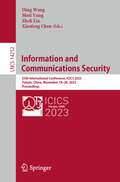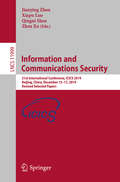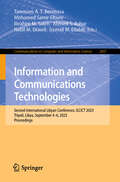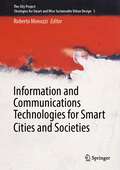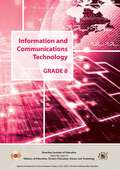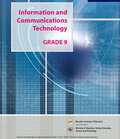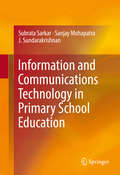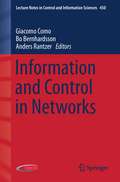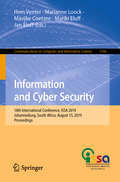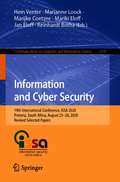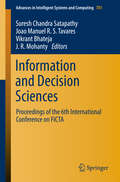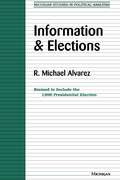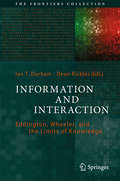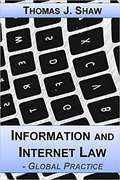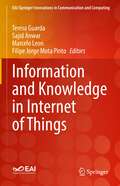- Table View
- List View
Information and Communications Security
by Lucas C. K. Hui S. H. Qing Elaine Shi S. M. YiuThis book constitutes the thoroughly refereed post-conference proceedings of the 16th International Conference on Information and Communications Security, ICISC 2014, held in Hong Kong, China, in December 2014. The 22 revised full papers including two invited talks presented were carefully selected from 90 submissions. The papers provide the latest results in research, development and applications in the field of information security and cryptology.
Information and Communications Security: 26th International Conference, ICICS 2024, Mytilene, Greece, August 26–28, 2024, Proceedings, Part I (Lecture Notes in Computer Science #15056)
by Sokratis Katsikas Christos Xenakis Christos Kalloniatis Costas LambrinoudakisThis two-volume proceedings set LNCS 15056-15057 constitutes the proceedings of 26th International Conference on Information and Communications Security, ICICS 2024, in Mytilene, Greece, during August 26-28, 2024. The 32 full papers presented in this book were carefully selected and reviewed from 123 submissions. They cover topics related to many aspects of security in information and communication systems, ranging from attacks, to defences, to trust issues, to anomaly-based intrusion detection, to privacy preservation, and to theory and applications of various cryptographic techniques.
Information and Communications Security: 26th International Conference, ICICS 2024, Mytilene, Greece, August 26–28, 2024, Proceedings, Part II (Lecture Notes in Computer Science #15057)
by Sokratis Katsikas Christos Xenakis Christos Kalloniatis Costas LambrinoudakisThis two-volume proceedings set LNCS 15056-15057 constitutes the proceedings of 26th International Conference on Information and Communications Security, ICICS 2024, in Mytilene, Greece, during August 26-28, 2024. The 32 full papers presented in this book were carefully selected and reviewed from 123 submissions. They cover topics related to many aspects of security in information and communication systems, ranging from attacks, to defences, to trust issues, to anomaly-based intrusion detection, to privacy preservation, and to theory and applications of various cryptographic techniques.
Information and Communications Security
by Kwok-Yan Lam Chi-Hung Chi Sihan QingIFIP/SEC2000, being part of the 16th IFIP World Computer Congress (WCC2000), is being held in Beijing, China from August 21 to 25, 2000. SEC2000 is the annual conference of TCll (Information Security) of the International Federation of Information Processing. The conference focuses on the seamless integration of information security services as an integral part of the Global Information Infrastructure in the new millenniUm. SEC2000 is sponsored by the China Computer Federation (CCF), IFIP/TCll, and Engineering Research Centre for Information Security Technology, Chinese Academy of Sciences (ERCIST, CAS). There were 180 papers submitted for inclusion, 50 papers among them have been accepted as long papers and included in this proceeding, 81 papers have been accepted as short papers and published in another proceeding. All papers presented in this conference were reviewed blindly by a minimum of two international reviewers. The authors' affiliations of the 180 submissions and the accepted 131 papers range over 26 and 25 countries or regions, respectively. We would like to appreciate all who have submitted papers to IFIP/SEC2000, and the authors of accepted papers for their on-time preparation of camera-ready fmal versions. Without their contribution there would be no conference. We wish to express our gratitude to all program committee members and other reviewers for their hard work in reviewing the papers in a short time and for contributing to the conference in different ways. We would like to thank Rein Venter for his time and expertise in compiling the fmal version of the proceedings.
Information and Communications Security: 22nd International Conference, ICICS 2020, Copenhagen, Denmark, August 24–26, 2020, Proceedings (Lecture Notes in Computer Science #12282)
by Weizhi Meng Dieter Gollmann Christian D. Jensen Jianying ZhouThis book constitutes the refereed proceedings of the 22nd International Conference on Information and Communications Security, ICICS 2020, held in Copenhagen, Denmark*, in August 2020. The 33 revised full papers were carefully selected from 139 submissions. The papers focus in topics about computer and communication security, and are organized in topics of security and cryptography.*The conference was held virtually due to the COVID-19 pandemic.
Information and Communications Security: 20th International Conference, ICICS 2018, Lille, France, October 29-31, 2018, Proceedings (Lecture Notes in Computer Science #11149)
by David Naccache Shouhuai Xu Sihan Qing Pierangela Samarati Gregory Blanc Rongxing Lu Zonghua Zhang Ahmed MeddahiThis book constitutes the refereed proceedings of the 20th International Conference on Information and Communications Security, ICICS 2018, held in Lille, France, in October 2018. The 39 revised full papers and 11 short papers presented were carefully selected from 202 submissions. The papers are organized in topics on blockchain technology, malware, botnet and network security, real-world cryptography, encrypted computing, privacy protection, signature schemes, attack analysis and detection, searchable encryption and identity-based cryptography, verifiable storage and computing, applied cryptography, supporting techniques, formal analysis and cryptanalysis, attack detection, and security management.
Information and Communications Security: 17th International Conference, Icics 2015, Beijing, China, December 9-11, 2015, Revised Selected Papers (Lecture Notes In Computer Science #9543)
by Sihan Qing Chris Mitchell Liqun Chen Dongmei LiuThis book constitutes the refereed proceedings of the 19th International Conference on Information and Communications Security, ICICS 2017, held in Beijing, China, in December 2017. The 43 revised full papers and 14 short papers presented were carefully selected from 188 submissions. The papers cover topics such as Formal Analysis and Randomness Test; Signature Scheme and Key Management; Algorithms; Applied Cryptography; Attacks and Attacks Defense; Wireless Sensor Network Security; Security Applications; Malicious Code Defense and Mobile Security; IoT Security; Healthcare and Industrial Control System Security; Privacy Protection; Engineering Issues of Crypto; Cloud and E-commerce Security; Security Protocols; Network Security.
Information and Communications Security
by Sihan Qing Eiji Okamoto Kwangjo Kim Dongmei LiuThis book constitutes the thoroughly refereed post-conference proceedings of the 17th International Conference on Information and Communications Security, ICISC 2015, held in Beijing, China, in December 2015. The 24 revised full papers and 19 short papers presented were carefully selected from 148 submissions. The papers provide the latest results in research and development in the field of information security and applied cryptology.
Information and Communications Security: 17th International Conference, ICICS 2015, Beijing, China, December 9-11, 2015, Revised Selected Papers (Lecture Notes in Computer Science #9543)
by Sihan Qing Eiji Okamoto Kwangjo Kim Dongmei LiuThis book constitutes the thoroughly refereed post-conference proceedings of the 17th International Conference on Information and Communications Security, ICISC 2015, held in Beijing, China, in December 2015.The 24 revised full papers and 19 short papers presented were carefully selected from 148 submissions. The papers provide the latest results in research and development in the field of information security and applied cryptology.
Information and Communications Security: 25th International Conference, ICICS 2023, Tianjin, China, November 18–20, 2023, Proceedings (Lecture Notes in Computer Science #14252)
by Ding Wang Moti Yung Zheli Liu Xiaofeng ChenThis volume LNCS 14252 constitutes the refereed proceedings of 25th International Conference on Information and Communications Security, ICICS 2023, held in Tianjin, China, during November 18–20, 2023. The 38 full papers presented together with 6 short papers were carefully reviewed and selected from 181 submissions. The conference focuses on: Symmetric-Key Cryptography; Public-Key Cryptography; Applied Cryptography; Authentication and Authorization; Privacy and Anonymity; Security and Privacy of AI; Blockchain and Cryptocurrencies; and System and Network Security.
Information and Communications Security: 21st International Conference, ICICS 2019, Beijing, China, December 15–17, 2019, Revised Selected Papers (Lecture Notes in Computer Science #11999)
by Jianying Zhou Xiapu Luo Qingni Shen Zhen XuThis book constitutes the refereed proceedings of the 21th International Conference on Information and Communications Security, ICICS 2019, held in Beijing, China, in December 2019. The 47 revised full papers were carefully selected from 199 submissions. The papers are organized in topics on malware analysis and detection, IoT and CPS security enterprise network security, software security, system security, authentication, applied cryptograph internet security, machine learning security, machine learning privacy, Web security, steganography and steganalysis.
Information and Communications Technologies: Second International Libyan Conference, ILCICT 2023, Tripoli, Libya, September 4–6, 2023, Proceedings (Communications in Computer and Information Science #2097)
by Tammam A. T. Benmusa Mohamed Samir Elbuni Ibrahim M. Saleh Ahmed S. Ashur Nabil M. Drawil Issmail M. EllabibThis book constitutes the proceedings of the Second International Libyan Conference on Information and Communication Technologies, ILCICT 2023, which took place in Tripoli, Libya, in September 4–6, 2023. The 26 full papers were carefully reviewed and selected from 55 submissions. The papers are organized in subject areas as follows: communication systems; computer and information systems; image processing, computer vision and internet of things.
Information and Communications Technologies for Smart Cities and Societies (The City Project #5)
by Roberto MenozziThis book offers an overview of digital, IoT and intelligent technologies, applications and solutions that are contributing to shape the digital, inclusive, and sustainable transformation of contemporary cities. Based on peer-reviewed contributions to the workshop "Information and Communications Technologies for Smart Cities and Societies", held on December 2, 2022, at the University of Parma, Italy, it offers a multidisciplinary, authoritative snapshot for researchers, architects, and engineers, as well as professionals and policy makers, involved in planning the city of the future. The book describes practical case studies, discussing challenges and opportunities of the integration of ICTs in the planning and management of future cities.
Information and Communications Technology class 7 - MIE
by Mauritius Institute of EducationThe Grade 7 ICT textbook for students in Mauritius is a comprehensive guide designed to facilitate a smooth transition from Grade 6, focusing on key competencies, knowledge, skills, attitudes, and values in Information and Communications Technology (ICT). The textbook's eight units cover diverse ICT topics, including computer operations, the Internet, word processing, spreadsheet, presentation, multimedia, and problem solving. Each unit is structured with activities, quick tests, summative exercises, and end-of-unit questions. An engaging feature is the introduction of an avatar named Tipiyu, providing guidance throughout the book. The curriculum emphasizes fundamental ICT principles, safety, ethics, and practical skills in areas such as programming using Scratch. The textbook aims to make learning accessible, empowering, and enjoyable for Grade 7 students, acknowledging the contributions of various stakeholders in its development.
Information and Communications Technology class 8 - MIE
by Mauritius Institute of EducationThe "Information and Communications Technology - Grade 8" textbook, published by the Mauritius Institute of Education in 2021, encompasses nine units covering a wide array of ICT topics. Aimed at Grade 8 students, it delves into fundamental aspects like computer operations, word processing, presentations, spreadsheets, internet usage, multimedia, health, safety, ethics, practical problem-solving, programming, and databases. Serving as a comprehensive guide, it equips students with a strong foundational understanding of ICT principles and skills crucial in today's world. The textbook's clarity and concise presentation facilitate easy comprehension, allowing students to grasp concepts effortlessly. With its detailed coverage and accessible language, this resource proves invaluable for students seeking to explore and comprehend the applications and significance of ICT in the modern era.
Information And Communications Technology class 9 - MIE
by Mauritius Institute of EducationThe Grade 9 ICT workbook is meticulously crafted to align with the National Curriculum Framework, recognizing the pivotal role of digital literacy in today's evolving landscape. With a strategic focus on technology's exponential growth, the workbook unfolds across nine comprehensive units, ranging from fundamental computer operations to practical problem-solving and programming. Through a learner-centric approach, the workbook amalgamates theoretical concepts with engaging practical activities, employing games, and exercises that foster hands-on learning experiences. Emphasizing continuous engagement, it encourages a year-long blend of theory and application. Symbolized guides like Tipiyu, carried over from previous grades, enrich the learning journey, while colored elements and symbols serve as aids, enhancing comprehension. Anchored in promoting ICT skills essential for a burgeoning knowledge society, this workbook primes students for the National Examination, nurturing their capacity to navigate digital environments, solve problems, and flourish in an increasingly tech-driven world.
Information and Communications Technology in Primary School Education
by Subrata Sarkar Sanjay Mohapatra J. SundarakrishnanThe main focus of this monograph is to discuss the role of technology in education in emerging markets considering that many countries have attempted to reform their educational systems using large scale interventions in the last two decades. Educational change can be prompted by two exact opposites in two different settings; for example, Western countries are faced with the problem of falling enrollments whereas developing countries have to adjust to rapid acceleration in enrollments. Based on the need to bring about change, these reforms subscribe to a large diversity including attempts at restructuring school systems, curriculum revisions, pedagogical change, technological change, assessment- related changes, work condition changes, and so on. Although there have been reforms in schools over the last century, they have been only first order classroom reforms; a 'deep-seated continuity' still persists in both schooling and teaching. Educational reforms are therefore plagued with different kinds of problems: the problem of successful initial change taking place, the problem of replicating successful change in varying contexts, and the problem of institutionalization or durability of the change. Readers will also discover that American India Foundation, having worked in the educational sphere for more than a decade, intends to transform the school ecosystem through its 'Digital Equalizer' Program (DE). The program strives to foster an environment of collaborative learning by effectively empowering teachers to use technology as a pedagogic tool leading to better learning outcomes among students of under-resourced schools across India. The author sheds new light on how the DE program is affecting change in the state of Odisha's education system and the adoption of new pedagogic teaching techniques.
Information and Control in Networks
by Giacomo Como Bo Bernhardsson Anders RantzerInformation and Control in Networks demonstrates the way in which system dynamics and information flows intertwine as they evolve, and the central role played by information in the control of complex networked systems. It is a milestone on the road to that convergence from traditionally independent development of control theory and information theory which has emerged strongly in the last fifteen years, and is now a very active research field. In addition to efforts in control and information theory, the text is witness to strong research in such diverse fields as computer science, mathematics, and statistics. Aspects that are given specialist treatment include: · data-rate theorems; · computation and control over communication networks; · decentralized stochastic control; · Gaussian networks and Gaussian-Markov random fields; and · routability in information networks. Information and Control in Networks collects contributions from world-leading researchers in the area who came together for the Lund Center for Control of Complex Engineering Systems Workshop in Information and Control in Networks from 17th-19th October 2012; the workshop being the centrepiece of a five-week-long focus period on the same theme. A source of exciting cross-fertilization and new ideas for extensive future research, this volume will be of great interest to any researcher or graduate student interested in the interaction of control and information theory.
Information and Cyber Security: 18th International Conference, ISSA 2019, Johannesburg, South Africa, August 15, 2019, Proceedings (Communications in Computer and Information Science #1166)
by Jan Eloff Hein Venter Marianne Loock Marijke Coetzee Mariki EloffThis book constitutes the refereed proceedings of the 18th International Conference on Information Security, ISSA 2019, held in Johannesburg, South Africa, in August 2019.The 12 revised full papers presented were carefully reviewed and selected from 35 submissions. The papers are dealing with topics such as authentication; access control; digital (cyber) forensics; cyber security; mobile and wireless security; privacy-preserving protocols; authorization; trust frameworks; security requirements; formal security models; malware and its mitigation; intrusion detection systems; social engineering; operating systems security; browser security; denial-of-service attacks; vulnerability management; file system security; firewalls; Web protocol security; digital rights management; distributed systems security.
Information and Cyber Security: 19th International Conference, ISSA 2020, Pretoria, South Africa, August 25–26, 2020, Revised Selected Papers (Communications in Computer and Information Science #1339)
by Hein Venter Marianne Loock Marijke Coetzee Mariki Eloff Jan Eloff Reinhardt BothaThis book constitutes the refereed post-conference proceedings of the 19th International Conference on Information Security, ISSA 2020, which was supposed to be held in Pretoria, South Africa, in August 2020, but it was held virtually due to the COVID-19 pandemic.The 10 revised full papers presented were carefully reviewed and selected from 33 submissions. The papers deal with topics such as authentication; access control; digital (cyber) forensics; cyber security; mobile and wireless security; privacy-preserving protocols; authorization; trust frameworks; security requirements; formal security models; malware and its mitigation; intrusion detection systems; social engineering; operating systems security; browser security; denial-of-service attacks; vulnerability management; file system security; firewalls; Web protocol security; digital rights management; and distributed systems security.
Information and Decision Sciences: Proceedings Of The 6th International Conference On Ficta (Advances In Intelligent Systems And Computing #701)
by Suresh Chandra Satapathy Vikrant Bhateja J. R. Mohanty Joao Manuel TavaresThis book presents the proceedings of the 6th International Conference on Frontiers of Intelligent Computing: Theory and Applications (FICTA-2017), held in Bhubaneswar, Odisha. The event brought together researchers, scientists, engineers, and practitioners to exchange their new ideas and experiences in the domain of intelligent computing theories with prospective applications to various engineering disciplines. The book is divided into two volumes: Information and Decision Sciences, and Intelligent Engineering Informatics. This volume covers broad areas of Information and Decision Sciences, with papers exploring both the theoretical and practical aspects of data-intensive computing, data mining, evolutionary computation, knowledge management & networks, sensor networks, signal processing, wireless networks, protocols & architectures etc. The book also offers a valuable resource for students at the post-graduate level in various engineering disciplines.
Information and Elections
by R. Michael AlvarezR. Michael Alvarez examines how voters make their decisions in presidential elections. He begins with the assumption that voters have neither the incentive nor the inclination to be well-informed about politics and presidential candidates. Candidates themselves have incentives to provide ambiguous information about themselves, their records and their issue positions. Yet the author shows that a tremendous amount of information is made available about presidential candidates. And he uncovers clear and striking evidence that people are not likely to vote for candidates about whom they know very little. Alvarez explores how voters learn about candidates through the course of a campaign. He provides a detailed analysis of the media coverage of presidential campaigns and shows that there is a tremendous amount of media coverage of these campaigns, that much of this coverage is about issues and is informative, and that voters learn from this coverage. The paperback edition of this work has been updated to include information on the 1996 Presidential election. Information and Electionsis a book that will be read by all who are interested in campaigns and electoral behavior in presidential and other elections. "Thoughtfully conceptualized, painstakingly analyzed, with empirically significant conclusions on presidential election voting behavior, this book is recommended for both upper-division undergraduate and graduate collections. " --Choice R. Michael Alvarez is Associate Professor of Political Science, California Institute of Technology.
Information and Interaction
by Ian T. Durham Dean RicklesIn this essay collection, leading physicists, philosophers, and historians attempt to fill the empty theoretical ground in the foundations of information and address the related question of the limits to our knowledge of the world. Over recent decades, our practical approach to information and its exploitation has radically outpaced our theoretical understanding - to such a degree that reflection on the foundations may seem futile. But it is exactly fields such as quantum information, which are shifting the boundaries of the physically possible, that make a foundational understanding of information increasingly important. One of the recurring themes of the book is the claim by Eddington and Wheeler that information involves interaction and putting agents or observers centre stage. Thus, physical reality, in their view, is shaped by the questions we choose to put to it and is built up from the information residing at its core. This is the root of Wheeler's famous phrase "it from bit. " After reading the stimulating essays collected in this volume, readers will be in a good position to decide whether they agree with this view.
Information and Internet Law: Global Practice
by Thomas ShawThe worlds of today and tomorrow rely upon open networks connecting far-flung participants exchanging information both personal and commercial. Bringing some certainty to this very dynamic environment are the legal foundations supporting the free flow of information over the Internet. <p><p> New lawyers, lawyers new to information and Internet law, lawyers updating their knowledge on the latest statutes and cases, and lawyers desiring a global comparative legal perspective are among the audiences who require this single resource to consolidate their understanding of global information and Internet law. This book, up-to-date to March 2018, provides insight by looking at current statutes, regulations, and directives in the United States and Europe, supplemented by statutes in Asia and the Americas ex-U.S. It discusses and identifies issues raised by the latest U.S. and EU cases on protection of information and use of the Internet. <p><p> It starts with a risk-based, lifecycle approach to this area of law. The areas of information law addressed: privacy, information security, and data protection law, unlawful data disclosures through cybercrime and data breach, and lawful data disclosures related to messaging and surveillance. The areas of Internet law addressed: access, jurisdiction, speech, intermediary liability, intellectual property, and e-commerce through electronic and website agreements. Bringing a unique perspective to explain a complex topic, the author has written numerous books on legal technology and legal history, writes and speaks extensively on the latest developments in technology law, teaches U.S.-EU comparative law school courses on information, Internet, and emerging technologies law, and had worked in complementary disciplines across the major parts of the world. This book is the result of those many years of experience and insight.
Information and Knowledge in Internet of Things (EAI/Springer Innovations in Communication and Computing)
by Teresa Guarda Sajid Anwar Marcelo Leon Filipe Jorge Mota PintoThis book provides readers with an insight into information and knowledge in the Internet of Things, in particular an investigation of data management and processing, information extraction, technology, knowledge management, knowledge sharing, knowledge co-creation, knowledge integration, and the development of new intelligent services available anytime, anywhere, by anyone. The authors show how IoT enables communication and ubiquitous computing between global citizens, networked machines and physical objects, providing a promising vision of the future integrating the real world of knowledge agents and things with the virtual world of information.
